Zhiqiang Ma
Entropy-Aware Branching for Improved Mathematical Reasoning
Mar 27, 2025Abstract:While Large Language Models (LLMs) are effectively aligned through extensive pre-training and fine-tuning, they still struggle with varying levels of uncertainty during token generation. In our investigation of mathematical reasoning, we observe that errors are more likely to arise at tokens exhibiting high entropy and variance of entropy in the model's output distribution. Based on the observation, we propose a novel approach that dynamically branches the generation process on demand instead of defaulting to the single most probable token. By exploring in parallel multiple branches stemming from high probability tokens of critical decision points, the model can discover diverse reasoning paths that might otherwise be missed. We further harness external feedback from larger models to rank and select the most coherent and accurate reasoning branch. Our experimental results on mathematical word problems and calculation questions show that this branching strategy boosts the reasoning capabilities of small LLMs up to 4.6% compared to conventional argmax decoding.
"What is the value of {templates}?" Rethinking Document Information Extraction Datasets for LLMs
Oct 20, 2024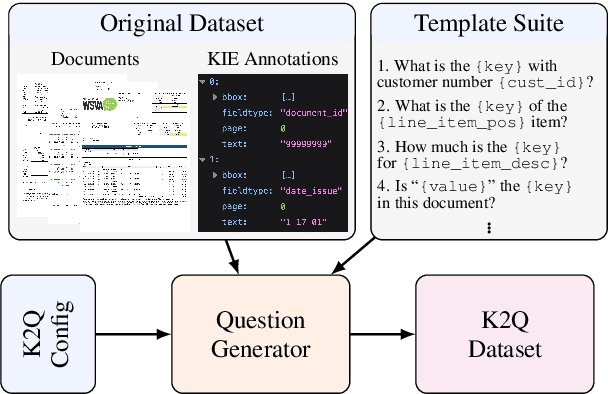
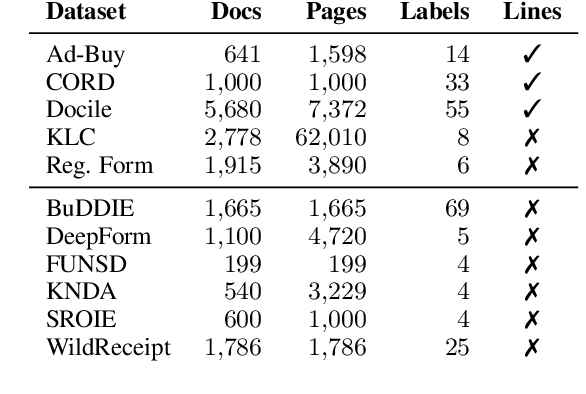
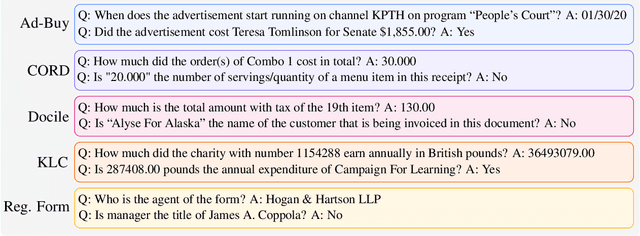

Abstract:The rise of large language models (LLMs) for visually rich document understanding (VRDU) has kindled a need for prompt-response, document-based datasets. As annotating new datasets from scratch is labor-intensive, the existing literature has generated prompt-response datasets from available resources using simple templates. For the case of key information extraction (KIE), one of the most common VRDU tasks, past work has typically employed the template "What is the value for the {key}?". However, given the variety of questions encountered in the wild, simple and uniform templates are insufficient for creating robust models in research and industrial contexts. In this work, we present K2Q, a diverse collection of five datasets converted from KIE to a prompt-response format using a plethora of bespoke templates. The questions in K2Q can span multiple entities and be extractive or boolean. We empirically compare the performance of seven baseline generative models on K2Q with zero-shot prompting. We further compare three of these models when training on K2Q versus training on simpler templates to motivate the need of our work. We find that creating diverse and intricate KIE questions enhances the performance and robustness of VRDU models. We hope this work encourages future studies on data quality for generative model training.
Fine-Tuning Language Models with Differential Privacy through Adaptive Noise Allocation
Oct 03, 2024
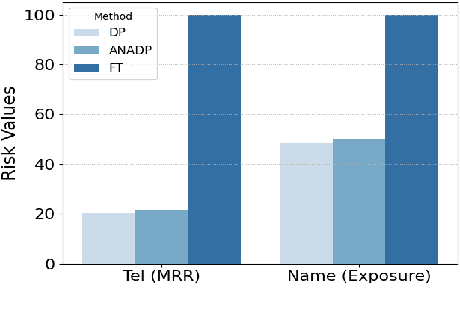
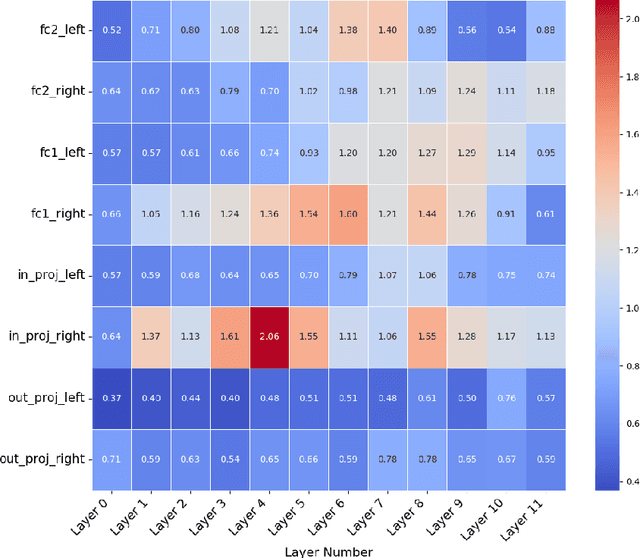

Abstract:Language models are capable of memorizing detailed patterns and information, leading to a double-edged effect: they achieve impressive modeling performance on downstream tasks with the stored knowledge but also raise significant privacy concerns. Traditional differential privacy based training approaches offer robust safeguards by employing a uniform noise distribution across all parameters. However, this overlooks the distinct sensitivities and contributions of individual parameters in privacy protection and often results in suboptimal models. To address these limitations, we propose ANADP, a novel algorithm that adaptively allocates additive noise based on the importance of model parameters. We demonstrate that ANADP narrows the performance gap between regular fine-tuning and traditional DP fine-tuning on a series of datasets while maintaining the required privacy constraints.
BuDDIE: A Business Document Dataset for Multi-task Information Extraction
Apr 05, 2024Abstract:The field of visually rich document understanding (VRDU) aims to solve a multitude of well-researched NLP tasks in a multi-modal domain. Several datasets exist for research on specific tasks of VRDU such as document classification (DC), key entity extraction (KEE), entity linking, visual question answering (VQA), inter alia. These datasets cover documents like invoices and receipts with sparse annotations such that they support one or two co-related tasks (e.g., entity extraction and entity linking). Unfortunately, only focusing on a single specific of documents or task is not representative of how documents often need to be processed in the wild - where variety in style and requirements is expected. In this paper, we introduce BuDDIE (Business Document Dataset for Information Extraction), the first multi-task dataset of 1,665 real-world business documents that contains rich and dense annotations for DC, KEE, and VQA. Our dataset consists of publicly available business entity documents from US state government websites. The documents are structured and vary in their style and layout across states and types (e.g., forms, certificates, reports, etc.). We provide data variety and quality metrics for BuDDIE as well as a series of baselines for each task. Our baselines cover traditional textual, multi-modal, and large language model approaches to VRDU.
TreeForm: End-to-end Annotation and Evaluation for Form Document Parsing
Feb 07, 2024Abstract:Visually Rich Form Understanding (VRFU) poses a complex research problem due to the documents' highly structured nature and yet highly variable style and content. Current annotation schemes decompose form understanding and omit key hierarchical structure, making development and evaluation of end-to-end models difficult. In this paper, we propose a novel F1 metric to evaluate form parsers and describe a new content-agnostic, tree-based annotation scheme for VRFU: TreeForm. We provide methods to convert previous annotation schemes into TreeForm structures and evaluate TreeForm predictions using a modified version of the normalized tree-edit distance. We present initial baselines for our end-to-end performance metric and the TreeForm edit distance, averaged over the FUNSD and XFUND datasets, of 61.5 and 26.4 respectively. We hope that TreeForm encourages deeper research in annotating, modeling, and evaluating the complexities of form-like documents.
DocGraphLM: Documental Graph Language Model for Information Extraction
Jan 05, 2024



Abstract:Advances in Visually Rich Document Understanding (VrDU) have enabled information extraction and question answering over documents with complex layouts. Two tropes of architectures have emerged -- transformer-based models inspired by LLMs, and Graph Neural Networks. In this paper, we introduce DocGraphLM, a novel framework that combines pre-trained language models with graph semantics. To achieve this, we propose 1) a joint encoder architecture to represent documents, and 2) a novel link prediction approach to reconstruct document graphs. DocGraphLM predicts both directions and distances between nodes using a convergent joint loss function that prioritizes neighborhood restoration and downweighs distant node detection. Our experiments on three SotA datasets show consistent improvement on IE and QA tasks with the adoption of graph features. Moreover, we report that adopting the graph features accelerates convergence in the learning process during training, despite being solely constructed through link prediction.
DocLLM: A layout-aware generative language model for multimodal document understanding
Dec 31, 2023

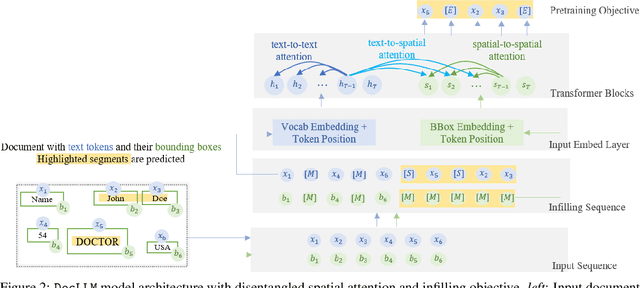

Abstract:Enterprise documents such as forms, invoices, receipts, reports, contracts, and other similar records, often carry rich semantics at the intersection of textual and spatial modalities. The visual cues offered by their complex layouts play a crucial role in comprehending these documents effectively. In this paper, we present DocLLM, a lightweight extension to traditional large language models (LLMs) for reasoning over visual documents, taking into account both textual semantics and spatial layout. Our model differs from existing multimodal LLMs by avoiding expensive image encoders and focuses exclusively on bounding box information to incorporate the spatial layout structure. Specifically, the cross-alignment between text and spatial modalities is captured by decomposing the attention mechanism in classical transformers to a set of disentangled matrices. Furthermore, we devise a pre-training objective that learns to infill text segments. This approach allows us to address irregular layouts and heterogeneous content frequently encountered in visual documents. The pre-trained model is fine-tuned using a large-scale instruction dataset, covering four core document intelligence tasks. We demonstrate that our solution outperforms SotA LLMs on 14 out of 16 datasets across all tasks, and generalizes well to 4 out of 5 previously unseen datasets.
Learning from Imperfect Demonstrations through Dynamics Evaluation
Dec 18, 2023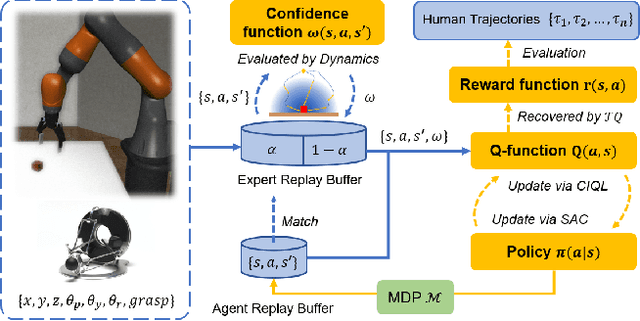
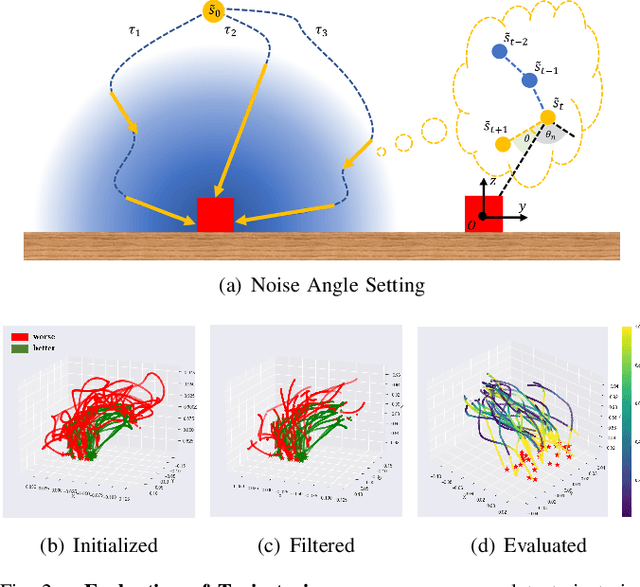

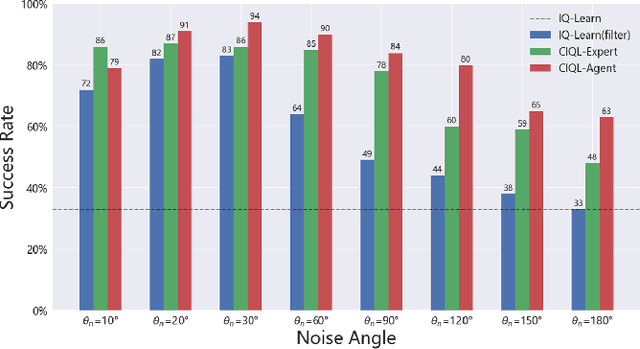
Abstract:Standard imitation learning usually assumes that demonstrations are drawn from an optimal policy distribution. However, in real-world scenarios, every human demonstration may exhibit nearly random behavior and collecting high-quality human datasets can be quite costly. This requires imitation learning can learn from imperfect demonstrations to obtain robotic policies that align human intent. Prior work uses confidence scores to extract useful information from imperfect demonstrations, which relies on access to ground truth rewards or active human supervision. In this paper, we propose a dynamics-based method to evaluate the data confidence scores without above efforts. We develop a generalized confidence-based imitation learning framework called Confidence-based Inverse soft-Q Learning (CIQL), which can employ different optimal policy matching methods by simply changing object functions. Experimental results show that our confidence evaluation method can increase the success rate by $40.3\%$ over the original algorithm and $13.5\%$ over the simple noise filtering.
Can GPT models be Financial Analysts? An Evaluation of ChatGPT and GPT-4 on mock CFA Exams
Oct 12, 2023



Abstract:Large Language Models (LLMs) have demonstrated remarkable performance on a wide range of Natural Language Processing (NLP) tasks, often matching or even beating state-of-the-art task-specific models. This study aims at assessing the financial reasoning capabilities of LLMs. We leverage mock exam questions of the Chartered Financial Analyst (CFA) Program to conduct a comprehensive evaluation of ChatGPT and GPT-4 in financial analysis, considering Zero-Shot (ZS), Chain-of-Thought (CoT), and Few-Shot (FS) scenarios. We present an in-depth analysis of the models' performance and limitations, and estimate whether they would have a chance at passing the CFA exams. Finally, we outline insights into potential strategies and improvements to enhance the applicability of LLMs in finance. In this perspective, we hope this work paves the way for future studies to continue enhancing LLMs for financial reasoning through rigorous evaluation.
Reducing the gap between streaming and non-streaming Transducer-based ASR by adaptive two-stage knowledge distillation
Jun 27, 2023Abstract:Transducer is one of the mainstream frameworks for streaming speech recognition. There is a performance gap between the streaming and non-streaming transducer models due to limited context. To reduce this gap, an effective way is to ensure that their hidden and output distributions are consistent, which can be achieved by hierarchical knowledge distillation. However, it is difficult to ensure the distribution consistency simultaneously because the learning of the output distribution depends on the hidden one. In this paper, we propose an adaptive two-stage knowledge distillation method consisting of hidden layer learning and output layer learning. In the former stage, we learn hidden representation with full context by applying mean square error loss function. In the latter stage, we design a power transformation based adaptive smoothness method to learn stable output distribution. It achieved 19\% relative reduction in word error rate, and a faster response for the first token compared with the original streaming model in LibriSpeech corpus.
 Add to Chrome
Add to Chrome Add to Firefox
Add to Firefox Add to Edge
Add to Edge